Surrounding Communities
Ben Wheeler Texas
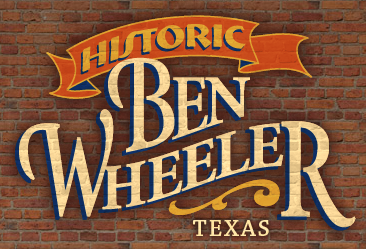 Ben Wheeler is an unincorporated community in Van Zandt County, Texas, United States. It lies twelve miles southeast of Canton, and has an estimated population of 400.
Ben Wheeler is an unincorporated community in Van Zandt County, Texas, United States. It lies twelve miles southeast of Canton, and has an estimated population of 400.
The area around Ben Wheeler was first settled in the 1840s by Kentucky farmer Benjamin F. Wheeler. Originally known as Clough, after prominent local farmer George W. Clough, the community was renamed Ben Wheeler in 1878 after the town’s post office was relocated to the present townsite. The community was beset by many hardships in its early years, including an 1893 fire which destroyed most of the town’s businesses. By 1896 the population reached 500, but disaster struck again by way of a smallpox epidemic that reduced the number of residents to 238 by 1904. Somewhat insulated from the effects of the Great Depression by the East Texas Oil Boom, Ben Wheeler had 18 businesses and a population of 375 in 1943. As the oil boom subsided and area cotton production fell, however, Ben Wheeler began a decline which led to the closing of all but nine area businesses by 1972, and the consolidation of its schools with those in nearby Van. By 1988, however, buoyed by the growth of nearby Tyler and Canton, the number of operating businesses in Ben Wheeler had risen to twenty-two and in 2000 the community was home to an estimated 400 residents.
Lonestar RV Parks is located approximately 40.1 miles via TX-198S
Forney Texas
 Forney is a city in Kaufman County, Texas, United States and has been named by the Texas legislature as the “Antique Capital of Texas”. It is part of the Dallas–Fort Worth metroplex. Its population was 14,661 at the 2010 census
Forney is a city in Kaufman County, Texas, United States and has been named by the Texas legislature as the “Antique Capital of Texas”. It is part of the Dallas–Fort Worth metroplex. Its population was 14,661 at the 2010 census
Lonestar RV Parks is located approximately 40.8 miles via US-175E
Dallas Texas
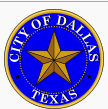 Dallas is a major city in Texas and is the largest urban center of the fourth most populous metropolitan area in the United States. The city proper ranks ninth in the U.S. and third in Texas afterHouston and San Antonio. The city’s prominence arose from its historical importance as a center for the oil and cotton industries, and its position along numerous railroad lines. The bulk of the city is in Dallas County, of which it is the county seat; however, sections of the city are located in Collin, Denton, Kaufman, and Rockwall counties. According to the 2010 United States Census, the city had a population of 1,197,816. The United States Census Bureau‘s estimate for the city’s population increased to 1,257,676, as of 2013.
Dallas is a major city in Texas and is the largest urban center of the fourth most populous metropolitan area in the United States. The city proper ranks ninth in the U.S. and third in Texas afterHouston and San Antonio. The city’s prominence arose from its historical importance as a center for the oil and cotton industries, and its position along numerous railroad lines. The bulk of the city is in Dallas County, of which it is the county seat; however, sections of the city are located in Collin, Denton, Kaufman, and Rockwall counties. According to the 2010 United States Census, the city had a population of 1,197,816. The United States Census Bureau‘s estimate for the city’s population increased to 1,257,676, as of 2013.
The city is the largest economic center of the 12-county Dallas–Fort Worth–Arlington metropolitan area, which had a population of 6,810,913 as of July 1, 2013. The metropolitan economy is the sixth largest in the United States, with a 2012 real GDP of $420.34 billion.] In 2013, the metropolitan area led the nation with the largest year-over-year increase in employment, and advanced to become the fourth-largest employment center in the nation (behind New York City, Los Angeles and Chicago) with more than three million non-farm jobs.[11] The city’s economy is primarily based on banking, commerce, telecommunications, computer technology, energy, healthcare and medical research, and transportation and logistics. The city is home to the third-largest concentration of Fortune 500companies in the nation. In the latest rankings released in 2013, Dallas was rated as a “beta plus” world city by the Globalization and World Cities Study Group & Network, and was 14th in world rankings of GDP by the Organisation for Economic Co-operation and Development.cated in North Texas, Dallas is the main core of the largest inland metropolitan area in the United States that lacks any navigable link to the sea. Dallas and nearby Fort Worth were developed due to the construction of major railroad lines through the area allowing access to cotton, cattle, and later oil in North and East Texas. The construction of the Interstate Highway System reinforced Dallas’ prominence as a transportation hub with four major interstate highways converging in the city, and a fifth interstate loop around it. Dallas developed as a strong industrial and financial center, and a major inland port, due to the convergence of major railroad lines, interstate highways, and the construction of Dallas/Fort Worth International Airport, one of the largest and busiest airports in the world.
Lonestar Rv Parks is located approximately 53.7 miles from Dallas via US-175E
Terrell Texas
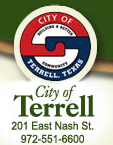 Terrell is a city in Kaufman County, Texas, United States. As of the 2010 census, the city population was 15,816. Terrell is located 32 miles (51 km) east of Dallas
Terrell is a city in Kaufman County, Texas, United States. As of the 2010 census, the city population was 15,816. Terrell is located 32 miles (51 km) east of Dallas
Terrell developed as a railroad town, beginning in 1873 with construction here of the Texas and Pacific Railroad line. The town was named for Robert A. Terrell, a pioneer European-American settler whose farm lay on its western edge. He built an octagonal house on his property, called a “Round House”, to provide better defense against attacks by Native Americans. They had occupied this territory for thousands of years. His house was later fitted with the first glass windows in the county. The community was incorporated in 1875.
The Terrell Military College was established here, operating until after World War II. Its campus was sited on part of the former Terrell farm and incorporated his historic Round House. In 1949 the Southern Bible Institute, based in Dallas and affiliated with the Churches of Christ, bought the military college property and transferred their operations here, renaming their institution Southwestern Christian College. It is a private, historically black college. The Round House has been preserved on campus, and is one of 20 such structures in the nation.
Lonestar RV Parks is approximately 32.7 miles from Terrell via TX-34S, US-175E and TX-274N
Tyler Texas
 Tyler is a city in and the county seat of Smith County, Texas, United States. It takes its name from President John Tyler. This city had a population of 96,900 in 2010, according to the United States Census Bureau. Tyler’s 2014 estimated population is 107,405. It is a hundred miles southeast of Dallas. Tyler is the principal city of the Tyler Metropolitan Statistical Area, with a population of 209,714 in 2010, and the regional center of the Tyler-Jacksonville combined statistical area, with a population of 260,559 in 2010.
Tyler is a city in and the county seat of Smith County, Texas, United States. It takes its name from President John Tyler. This city had a population of 96,900 in 2010, according to the United States Census Bureau. Tyler’s 2014 estimated population is 107,405. It is a hundred miles southeast of Dallas. Tyler is the principal city of the Tyler Metropolitan Statistical Area, with a population of 209,714 in 2010, and the regional center of the Tyler-Jacksonville combined statistical area, with a population of 260,559 in 2010.
Tyler has the nickname “Rose Capital of the World”. It gained this name due to the large quantity of rose bushes processed through the area, along with hosting America‘s largest rose garden.
In 1985, the international Adopt-a-Highway movement originated in Tyler when, after appeals by local Texas Department of Transportation officials, the local Civitan chapter adopted a two-mile (3-km) stretch of U.S. Highway 69. Tyler is also home to the Caldwell Zoo and Broadway Square Mall.
As a regional educational and technology center, Tyler is the host for more than 20,000 higher education students, a College of Engineering, and a University Health Science Center, two regional, billion-dollar hospital systems, and a variety of technology startups.
Lonestar RV Parks is located approximately 59 miles from Tyler Texas via TX-31W
Canton Texas
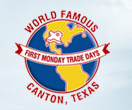 Canton is a city in and the county seat of Van Zandt County in East Texas, United States. As of the 2010 census, the city had a total population of 3,581
Canton is a city in and the county seat of Van Zandt County in East Texas, United States. As of the 2010 census, the city had a total population of 3,581
Canton was surveyed as early as 1840 by a company of men under Dr. W. P. King. The community stands on the original survey of Jesse Stockwell, an early settler in the area. No settlement was made until 1850, when the town was laid out and named by settlers moving from Old Canton in Smith County, Texas. The first district courthouse at Canton opened in 1850, and a post office, the county’s fourth, was established in that year.
When the Texas and Pacific Railway was built across the county in 1872, it missed Canton by ten miles, and the citizens of Wills Point persuaded county officials to move the county seat there. In the resulting dispute, in 1877 armed residents of Canton went to Wills Point to recover the records, and the county judge wired Governor Richard B. Hubbard for aid. The Texas Supreme Court finally decided in favor of Canton. Unwilling to use the railroad at Wills Point, Canton businessmen established Edgewood, ten miles (16 km) to the northwest of town, and built an extension to the railroad at a siding formerly called Stevenson.
Property for the town’s first school, the Canton Academy, was acquired in 1853. Sid S. Johnson began publication of the Canton Weekly Times, the county’s first newspaper, in 1860. A Grange was founded in 1876. By 1890 Canton had a population of 421, flour mills, sawmills, cotton gins, and a bank. Brick buildings were under construction by 1892 and a new brick courthouse was completed in 1894. Iron ore and anthracite coal were discovered in 1887 and 1891. By 1896, the town reached a population high of 800 and had several churches, a steam gristmill and gin, two weekly newspapers, three general stores and two hotels. But the population had fallen back to 421 by 1904.
Canton was incorporated in 1919, and elected a mayor and aldermen. Despite the Great Depression, development of the Van oilfield after 1929 brought further expansion. A Public Works Administrationproject in the 1930s saw the completion of a new courthouse. In 1933 area schools registered 500 white and twenty-eight black students. The population reached 715 in 1940, but dwindled again after 1949. In the 1950s, local business included a sweet-potato curing plant, an ice factory, a concrete-tile factory, lumberyards, and a cotton gin. Expansion of the Canton city limits doubled its territory in the 1960s. In 1970 the community had a municipal lake with recreational facilities, seven churches, a school, a bank, a library, a newspaper, and eighty-six businesses. The population doubled between 1960 and 1970 from roughly 1,000 to 2,000, and reached nearly 3,000 by 1990. The population was 3,292 in 2000. However, when the city council decided to recount the population, they found that the town had 5100 residents instead of the previous census total of 3,292.
Canton is known for its First Monday Trade Days. According to various sources, the tradition began with district court meetings held on the first Monday of each month, or with the monthly visit of neighbors iduring the days of the Confederate States of America. The custom began with the swapping of surplus stock by barter and grew to include casual bargaining for or swapping of dogs, antiques, junk, and donkeys on a 30-acre (120,000 m2) grounds. It is so immensely popular, that Canton goes from a town of 5,100 to a town of over 300,000 during the first Monday weekend, making it the largest flea market in the world. In the past, due to the success of First Monday, the city of Canton had no property tax, however, as of 2006, that is no longer the case.
Canton also holds The Van Zandt County Fair and Rodeo and an Annual Bluegrass Festival, which takes place in August. Between 2003 and 2007, Canton was the host community for the United States Equestrian Drill Championship (Super Ride), which showcases top color guard and mounted drill teams from throughout the country.
Lonestar RV Parks is located approximately 28.9 miles from Canton via TX-198S
Corsicana Texas
 Corsicana is a city in Navarro County, Texas, United States. It is located on Interstate 45, some fifty-five miles (eighty-nine kilometers) south of downtown Dallas. The population was 23,770 at the 2010census. It is the county seat of Navarro County
Corsicana is a city in Navarro County, Texas, United States. It is located on Interstate 45, some fifty-five miles (eighty-nine kilometers) south of downtown Dallas. The population was 23,770 at the 2010census. It is the county seat of Navarro County
Founded in 1848, Corsicana was named by José Antonio Navarro after the Mediterranean island of Corsica, the birthplace of his father, who died when Navarro and his many siblings were young. The first school opened shortly afterwards in 1849.
Women’s groups have had a strong role throughout the history of the city, with one of the earliest efforts being the establishment of the Corsicana Female Literary Institute, a school which operated from 1857 through 1870. The first public library in Corsicana opened in 1901 by effort of the women’s clubs of the city. A 1905 library gift by Andrew Carnegie gave the library a permanent home and its first full-time, professionally trained librarian. The library today is housed in a dedicated building downtown and boasts more than 52,283 books, 6,306 audio materials, 783 video materials, and 122 serial subscriptions.
The Corsicana Jewish community dates from 1871; while there are few Jewish residents of Corsicana today, the Historical Society has restored the 1898 Moorish Revival Temple Beth-El, Corsicana, now used as a community center.
The Corsicana YMCA was founded in 1884, and has grown with patron funding facilitated by local community leaders over 125 years, including in its earliest days George Taylor Jester (1847–1922), a wealthy dry goods and cotton distributor, banker, lieutenant governor of Texas (1895–1899), and the father of a later governor of Texas, Beauford H. Jester (1947–1949).
The Corsicana oil field was accidentally discovered in 1894 by water prospectors hired by the Corsicana Water Development authority. It was the first commercially significant oilfield find in Texas. An even larger oil field, the Powell oil field, was discovered in 1923 a few miles east of Corsicana. Another significant area oil and gas find occurred in 1956. Each oil and gas discovery brought a renewed development boom to the city.
During World War II, an airman flying school called Corsicana Air Field trained thousands of pilots
Lonestar RV Parks is located approximately 28.8 miles from Corsicana via Cedar Creek Parkway.
Kerens Texas
Kerens is a city in Navarro County, Texas, United States. The population was 1,681 at the 2000 census.
Kerens was established in 1881 when the St. Louis Southwestern Railway of Texas was built through the county, according to the Texas Handbook of History, and was named for Judge R. C. Kerens of St. Louis. The railroad bypassed the nearby settlement of Wadeville, and within a short time all of the businesses from Wadeville moved to the new town. By the mid-1890s, the handbook said, the town had three cotton gin-mills, four grocery stores, two hotels, two drug stores, a wagonmaker, and a weekly newspaper named the Navarro Blade. Kerens is a growing and friendly Central Texas city conveniently situated between Corsicana and Athens on SH 31. The city lies about 70 miles southeast of downtown Dallas and some 180 miles from Houston..
One of the city’s most well-known hometown boys is Big Tex. He now stands on the grounds of the State Fair of Texas and greets visitors from around the world. But Big Tex started life in Kerens as the world’s largest Santa Claus.
He was built and erected by local citizens and stood in the middle of Colket Avenue, the Kerens main street during the years of 1948 and 1949. From there he warmly welcomed passersby during the holidays. After two years, however, he was adopted by the State Fair of Texas and became Big Tex.
Lonestar RV Parks is located approximately 22 miles from Kerens via TX-31E and TX-274N
Scurry Texas
Scurry is a town in Kaufman County, Texas, United States. It was incorporated in 2003. A July 1, 2008 U.S. Census Bureau estimate placed the population at 719.
The first settlers in the area arrived in the mid-1840s. Over the next quarter century, a church and school community developed and the number of farms increased. The arrival of the Texas and Pacific Railway in the 1870s established the settlement as a shipment point for area farmers. When local residents requested a post office, they submitted the name Scurry – in honor of Scurry Dean, who was killed during the Civil War. Post service began in 1883 and a year later, Scurry had an estimated population of fifty. By 1914, the community was home to around 400 people as well as a number of businesses. The Great Depression caused Scurry to decline, which lasted through the first decade after World War II. Only 250 people remained in the community by the mid-1950s. The trend was later reversed during the latter half of the twentieth century. In 1990, there were nine businesses and approximately 315 people living in the community. That figure approached 600 by 2000 and Scurry was officially incorporated as a town three years later.
Scurry Texas is approximately 21.7 miles from Lonestar RV Parks via FM-148S and TX-274S
Gun Barrel Texas
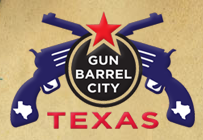 Gun Barrel City is a city in Henderson County, Texas, United States. The population was 5,672 at the 2010 Census.
Gun Barrel City is a city in Henderson County, Texas, United States. The population was 5,672 at the 2010 Census.
The town began as an unincorporated community known as the “Old Bethel Community” in the 1960s after completion of Cedar Creek Reservoir. It was incorporated in the late 1960s so it could legally sell beer and wine. The city takes its name from a former road, Gun Barrel Lane (which is now State Highway 198), as well as its motto, “We Shoot Straight with You” and its symbol – a rifle with two crossed antique pistols. Gun Barrel Lane got its name during the 1920s and ’30s when outlaws frequented the area. It was considered a safe backwoods place during Prohibition when the likes of Clyde Barrow and Bonnie Parker hung out in the area. A local resident, Mr. C. L. Wait, lived along the road and was known for sitting at the window of his house with a shotgun sticking out the window. It was his way of deterring those he deemed unwelcome on this back country road.
Despite having a name that evokes images of the Texas Frontier, Gun Barrel City is only fifty years old. Not long after Cedar Creek Lake (a reservoir for the Tarrant Regional Water District) completed construction, the fledgling community that sat on its banks took steps to officially become a city.
Gun Barrel City was incorporated on May 26, 1969. Since that time, Gun Barrel City has grown into the central hub and access point for the waters of Cedar Creek Lake. This has led visitors from around the region to use Gun Barrel City as the gateway into the lake. In addition to the high amount of tourism that the community witnesses (particularly during the summer boating season), Gun Barrel City and the surrounding communities have experienced a residential building boom over the past several years. This growth has largely been led by the relocation of wealthy retirees from throughout the Dallas region, building large lake homes in order to take advantage of Gun Barrel City’s lake access.
In May 2000, Gun Barrel City voters elected their 13th Mayor, 21-year-old Entrepreneur and Newspaper Publisher, Randal Tye Thomas, who became a media and political celebrity in the Dallas, Texas metropolitan area. After a very successful year as Mayor, marked by widespread community support, he resigned suddenly in May 2001 following a Grand Jury indictment for one count of misdemeanor perjury and in the same week being arrested by the Gun Barrel City Police Department for Public Intoxication. All criminal charges were eventually dismissed. Thomas and the community were featured in many local, state, and national publications and programs, including a feature story in the magazine Texas Monthly and a feature interview on the popular nationwide NPR program This American Life. Thomas moved to the Dallas, Texas area in 2002.
In 2008, Gun Barrel City received the coveted Certified Retirement Community recognition from the Texas Department of Agriculture’s Go Texan program. The community has also received recognition from the Governor’s Office, receiving second place on two separate occasions in the Governor’s Community Achievement Awards.
Lonestar RV Parks is located approximately 4 miles from Gun Barrel Texas via TX-334W

